Trend Report: These Are The 5 Most Important Tech Trends for SMBs in 2023
As a small-business leader, you know how important it is to invest in your business. But that’s only half the battle. Knowing how to invest is what can set up your small business for success and stay ahead of the competition.
But how do you get started in making the right technology investment? We conducted the 2023 SMB Tech Trends Survey* where we asked small-business leaders like you about their buying behaviors in the past 12 months to gain insight into how they’re investing in technology heading into 2023.
Based on these insights, we’ve identified the five most important tech trends for small-business leaders to learn from in 2023. Here’s what we found:
Five most important tech trends in 2023
61% of U.S. small businesses reported that they have buyer’s remorse over at least one technology purchase in the past 12-18 months.
Small businesses reported that lackluster support was their top reason (39%) for regretting a technology investment.
More than half of SMBs (59%) say they "continuously" or "very often" invest in new technology, and approach emerging technology "very" or "somewhat" boldly (56%).
A majority of U.S. small businesses (52%) reported that internal IT professionals are solely responsible for the evaluation, selection, and purchase of new software.
SMBs that prefer off-the-shelf software (62%) and those that prefer customized solutions (68%) had similar rates of post-purchase regret. But only 32% of small businesses with no preference between customized and off-the-shelf software reported purchase regret.
While these numbers are interesting, the more important question is: What can you, as a small-business leader, do with this information? Let’s get into it.
1. Don’t let a bad software purchase trip you up
Picture this: You’ve landed on a new software system after months of researching, reading reviews, and sitting through demos. A week into rolling it out, you discover the new system is missing an important feature, crashes in critical situations, or has unresponsive technical support. Now you have buyer’s remorse even after all your due diligence. You’re not alone.
While it would be nice to find the perfect software for your business 100% of the time, this is unlikely based on our survey findings that 61% of small businesses in the U.S. report buyer’s remorse over a technology purchase in the past year to year and a half. And if you are in the minority of businesses that have aced every tech investment (or you’re in denial), the chances of making a regrettable purchase increase as your business grows.
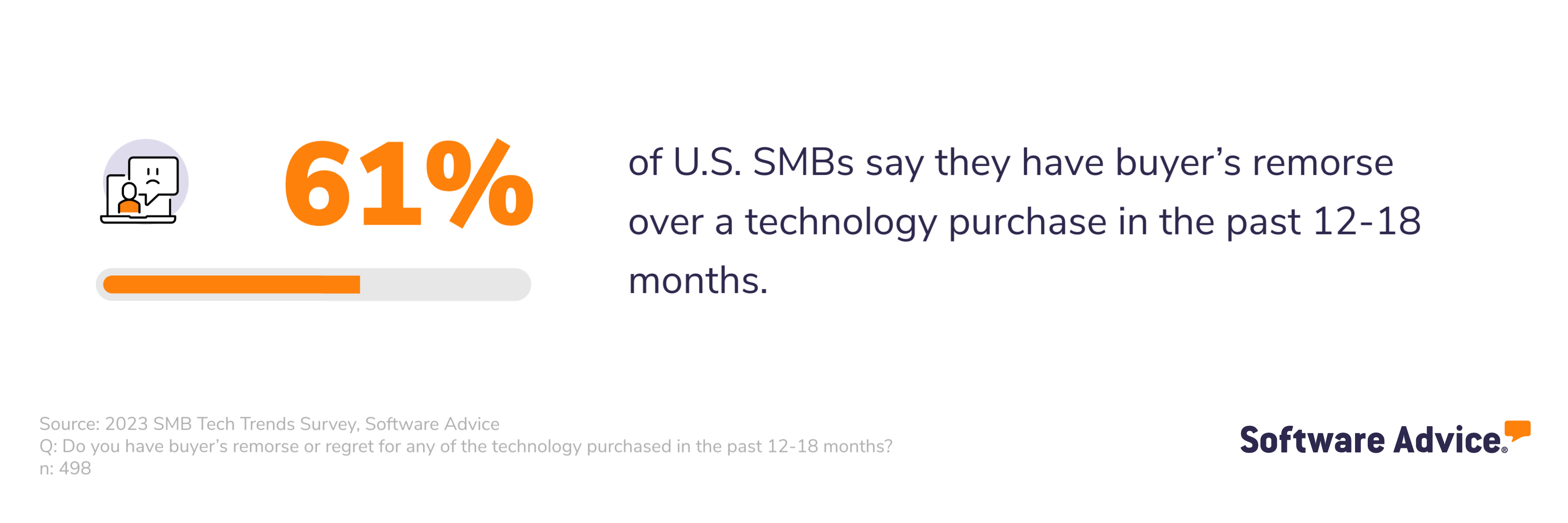
SMBs are racing to find and adopt the latest and greatest technologies in order to outperform competitors and stay relevant for customers. But don’t forget about your budget and functionality requirements, especially as your business scales. Take the steps to minimize your risk of buyer’s remorse by setting clear requirements for what you need, reading verified reviews, and evaluating software before purchasing.
You can also learn from regrettable purchases by looking back to see what went wrong. Was there another question you could have asked during a demo? Was there an important feature that you forgot to add to your requirements list?
Use our Ultimate Software Vendor Evaluation Guide as a reference when evaluating any new software vendor.
The takeaway: Accept the fact that you will eventually make a regrettable tech investment, but take the steps you can (plan, research, evaluate) to set your business up for as much success as possible so you can invest confidently in new technology.
2. Good support is just as important as good software
Let’s say you’ve done your research for the best accounting software for your business. After reading glowing reviews and spending a week testing out the product with your team, you make the purchase. Now it’s time to do payroll and you run into a bug that prevents your employees from getting paid. You email the vendor support team and get crickets. Now what?
This is why vendor support is so crucial to any technology investment, as evidenced by our survey results that found lackluster support was the number one reason (39%) businesses regretted a technology investment. In fact, our survey respondents reported that good support was even more important than overall cost (34%) and return on investment (33%).
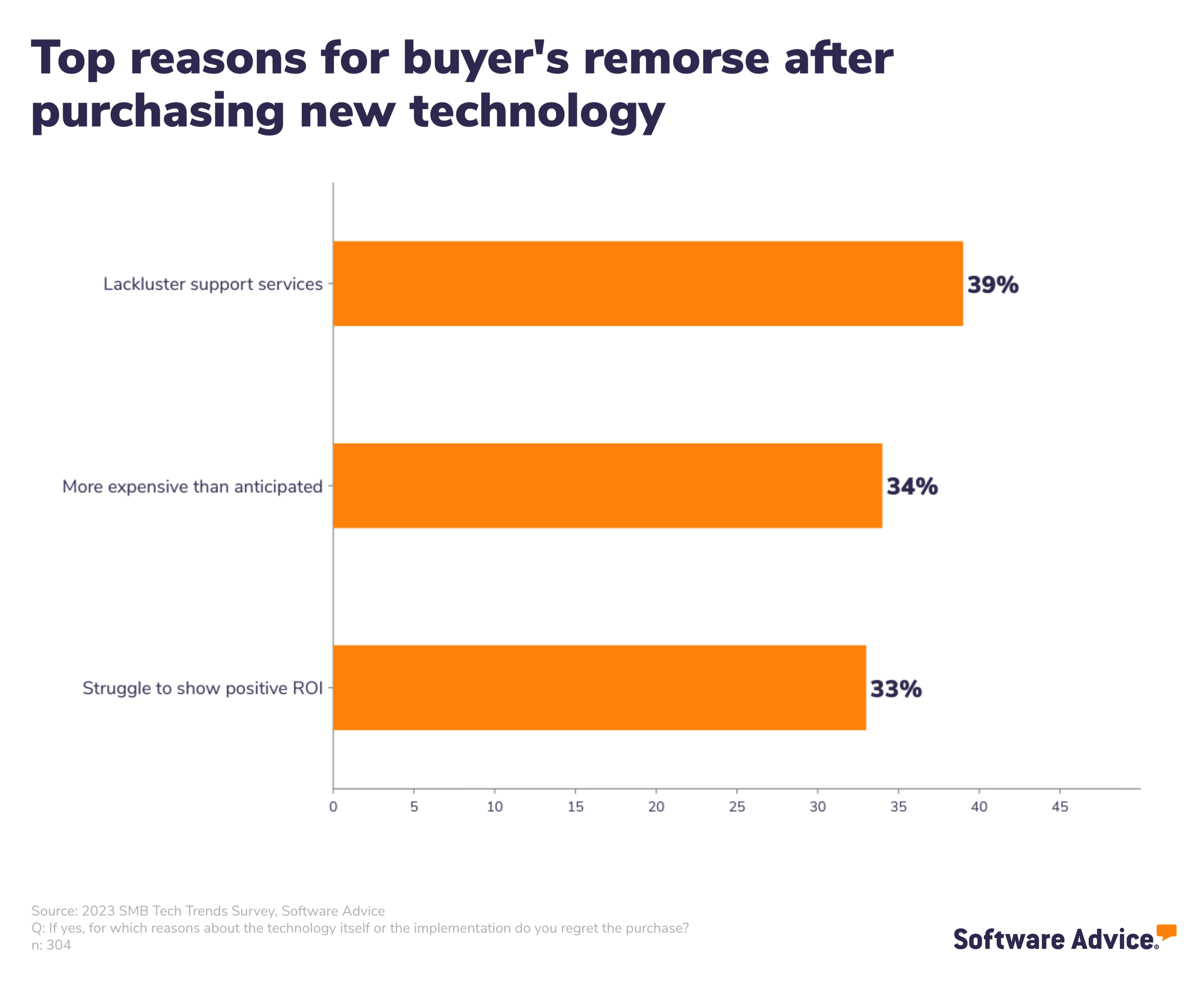
Learn from your peers and keep these numbers in mind during the evaluation stage of new technology research. It’s important to focus on support services, be flexible (where you can) with your budget, develop an ongoing relationship with your vendor, and total cost of ownership to effectively measure ROI over time.
The takeaway: Post-purchase support should be a top requirement in your list of software needs. The verified user reviews in our software directory are broken down into secondary ratings for customer support, ease-of-use, value for money, and functionality to ensure you’re investing in software with good support.
3. If you’re standing still you’re falling behind
Let’s say you decide to circumvent new technology investment pitfalls altogether by sticking with the software you’ve been using for years, warts and all. Meanwhile, your competition is benefitting from advances like AI-powered features, more streamlined user interfaces, and faster processing that come standard with modern, off-the-shelf software packages.
A conservative approach to technology investment, based on the buyer’s remorse statistic highlighted above, might be to stick with the technology you already have for as long as possible out of caution. But this approach would be folly. Why? Because more than half of your small-business leader peers (59%) are perpetually investing in new technology.
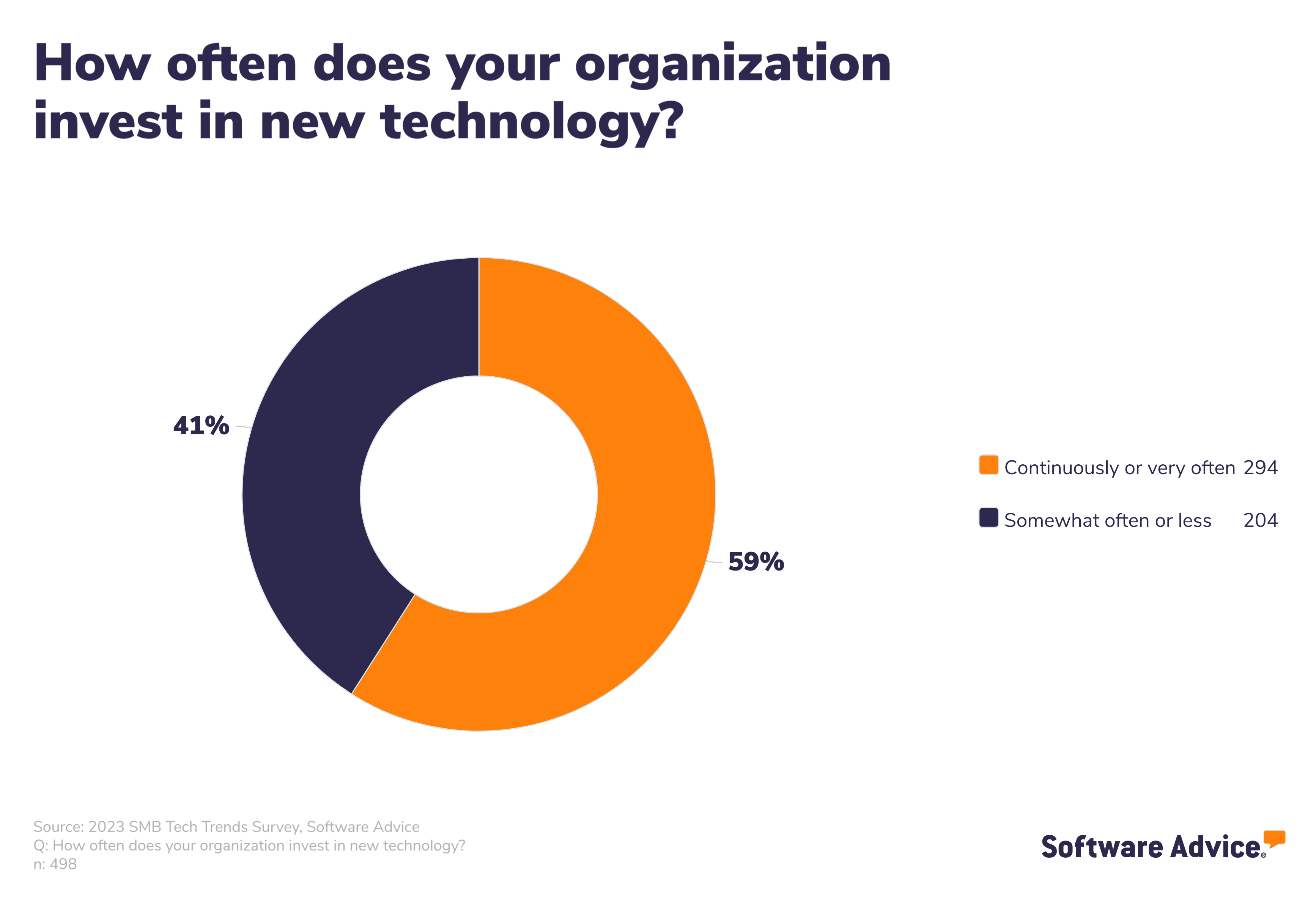
It’s clear that technology investment spend is growing for businesses and SMB leaders are more likely than ever to lean into new software as a major driver of productivity and efficiency, not to mention improve the client experience.
The takeaway: The business software industry is thriving, with revenue projected at over $300 billion in the U.S. alone for 2023 [1]. Software vendors are constantly innovating and improving their offerings, and if you’re still using technology that is 10 years old, you’re missing out on a decade of innovation.
If it’s been awhile since you’ve purchased new software and you’re feeling uncertain, fear not. Schedule a call or click here to chat with a software advisor now.
4. Don’t let your IT team choose your new software for you
Getting your IT team’s input on a new technology investment is a good idea, but letting them take complete control of the software acquisition process could be a major factor into why many businesses end up regretting the investment. Your IT team is uniquely positioned to select new network security software, for example, but they shouldn’t be choosing your social media management or HR software for you. Still, more than half (52%) of the small-business leaders that responded to our survey reported that someone from their information technology team was solely responsible for the evaluation, selection, and purchase of their new software.
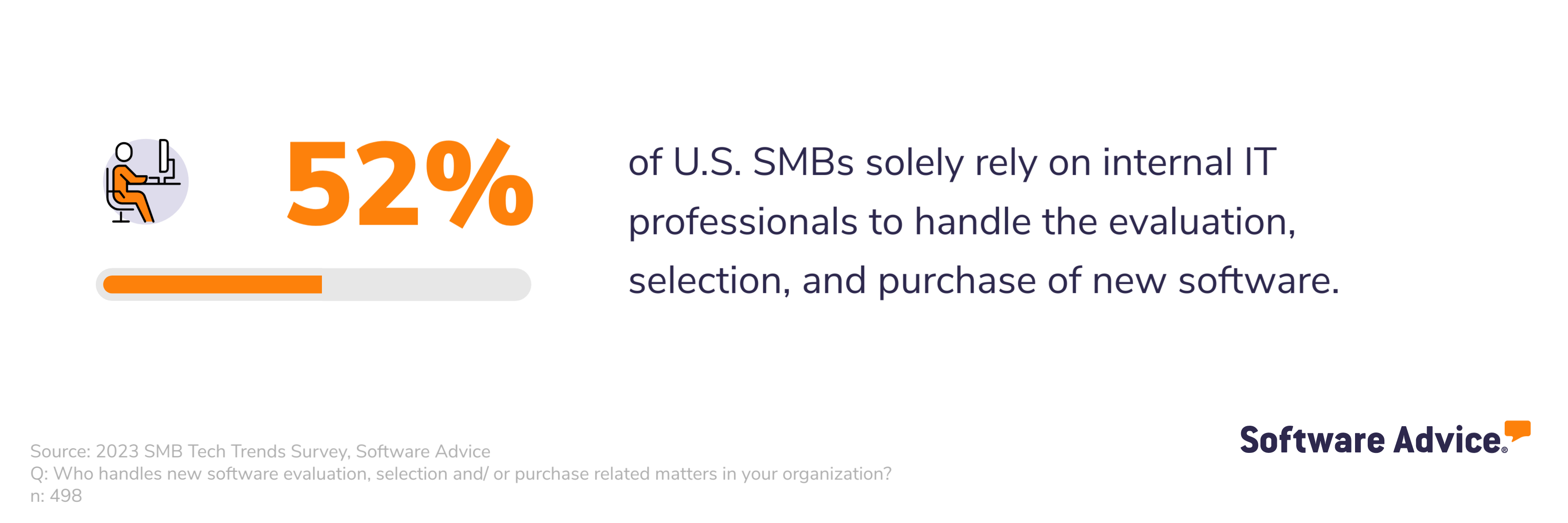
This is not to downplay the value of input from your IT team. It's still important to leverage their expertise to help understand compatibility with your existing systems and potential security vulnerabilities, for example. But leaving the entire evaluation process up to IT is a major mistake because they’re not the ones who will be using the software everyday.
The takeaway: Get your IT team’s input on a new technology investment, but put more weight on the opinion of the team that will be using the new technology the most. After you’ve narrowed down your list of potential options for new software (by browsing our directory and speaking to an advisor), let the teams who will be using it most evaluate it and sit in on a vendor demo.
5. Keep an open mind for the best chance of a successful investment
When it comes to off-the-shelf versus customized solutions, you might be dead set on one or the other. Perhaps your heart is set on using an off-the-shelf content management system only to find that an existing system with a few simple customizations could save your team hours of work. Or you might reconsider your insistence on a customized CRM solution when you find that an off-the-shelf tool can do everything you need with a few easy integrations.
If you head into a software purchase journey with a strong preference, you could be setting your business up for disappointment. According to our survey results, SMBs who preferred off-the-shelf solutions or customized solutions ended up regretting their purchase about two-thirds of the time, while businesses that had no preference regretted their investment less than one-third of the time.
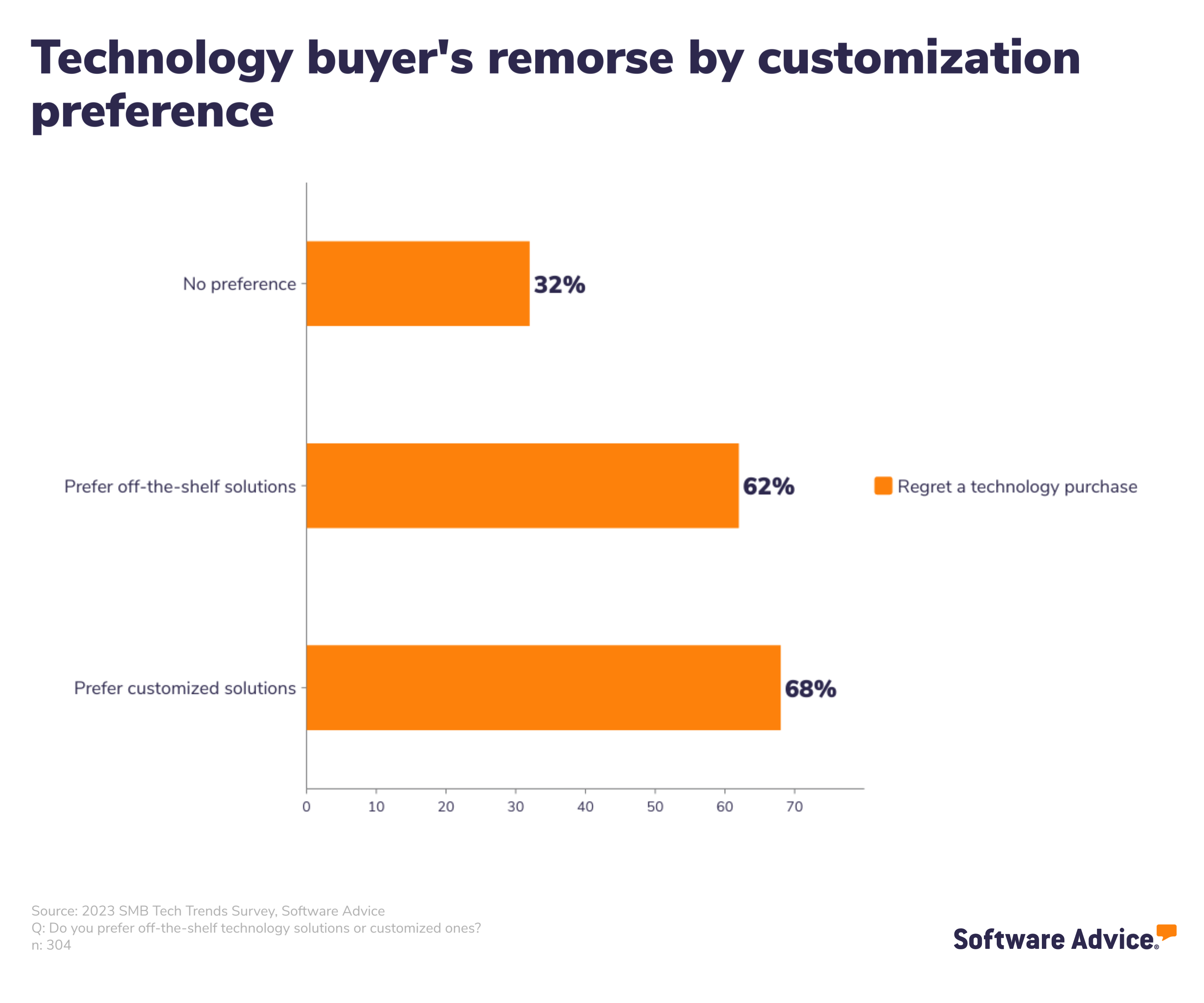
Keep an open mind during your investment journey. That way, you’ll avoid being locked into a higher cost, complicated implementation, or a longer timeline. In fact, many modern off-the-shelf systems include enough options to deliver the functionality SMBs need.
The takeaway: When it comes to customization options, remain flexible and don’t lock yourself into any preferences until you’ve given yourself a chance to carefully review your options. You may be surprised by the functionality options included in modern off-the-shelf systems.
Key takeaways for small businesses
That was a lot of ground to cover, so to summarize the key takeaways from our survey:
Do your due diligence when evaluating new software, and when you do make a regrettable purchase, use the lessons learned for future investments.
Focus on post-purchase support, total cost of ownership, and return on investment when making a new technology investment.
Keep up with the latest tech innovations, otherwise your business might miss out on technologies that could help you outperform your competitors.
Get your IT team’s input on any new technology investment, but put more weight on the opinion of the team that will actually be using the software.
Put aside any preconceived notions of off-the-shelf vs. customized solutions until you’ve had a chance to carefully evaluate all of your options.
Find more information on selecting the right software or creating a shortlist of vendors that meet your specific needs by connecting with an advisor or browsing our software buying resources on Software Advice.
Survey methodology
* Software Advice's 2023 SMB Tech Trends Survey was conducted from August through September 2022, among 1,526 respondents across the U.S., UK, Canada, Australia, and France to identify the technology needs, challenges, and trends for small businesses. Respondents were required to be involved in the technology purchasing decisions at companies with 2 to 999 employees and revenues less than $1 billion. A subset of 498 respondents have their primary workplace as the U.S.